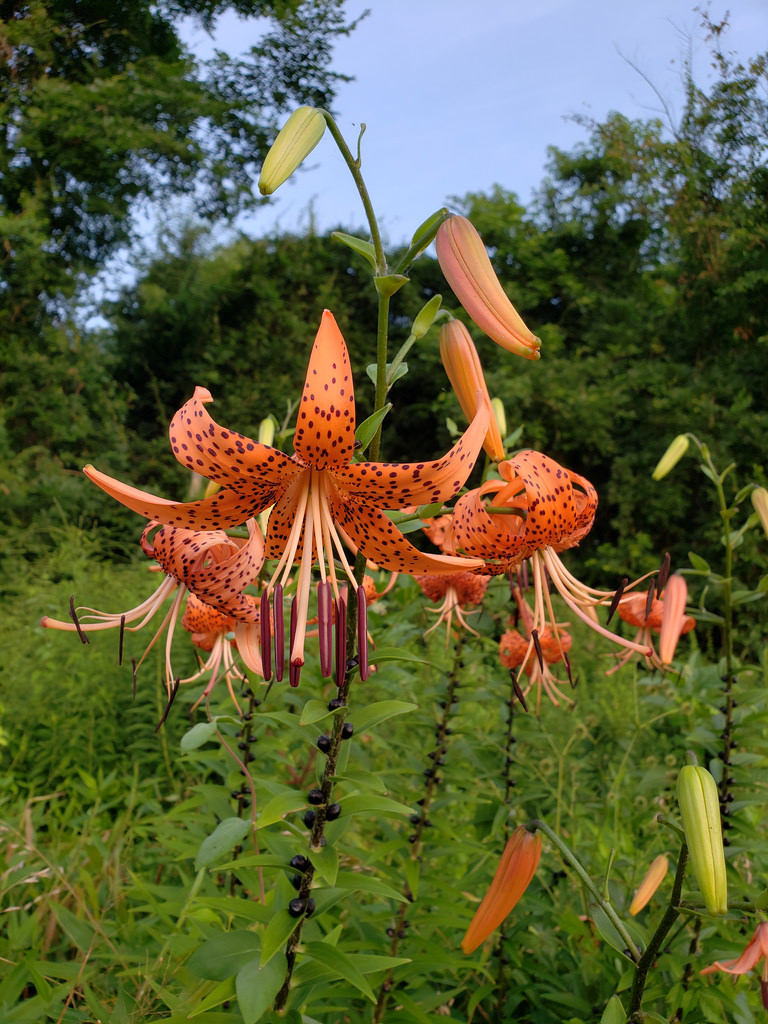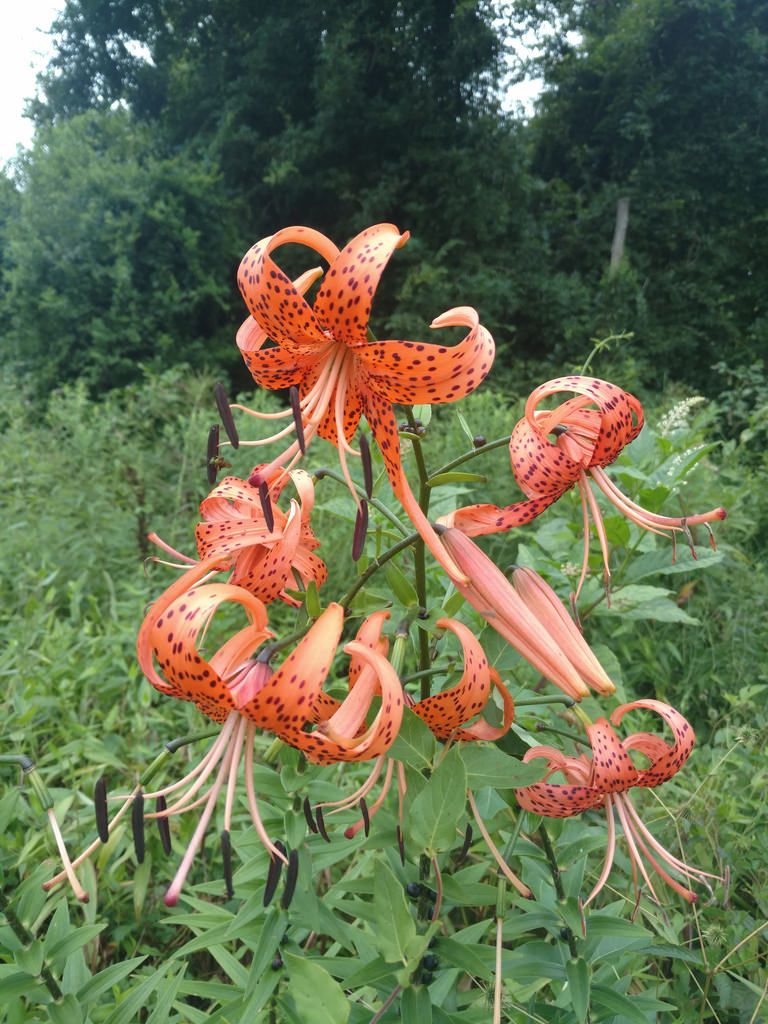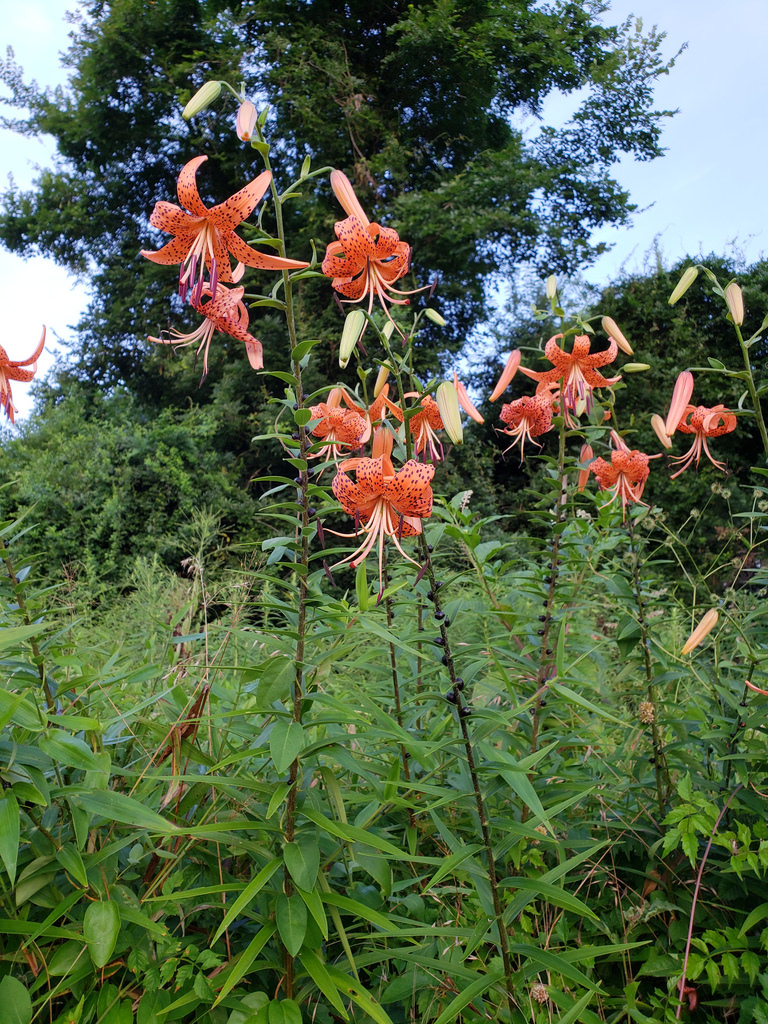Map Snapshot




7 Records
Description
Compare our native Turk's-cap Lily. Note bulbils in the leaf axils as well as black papillae on the orange flowers.
Seasonality Snapshot
Source: Wikipedia
| Lilium lancifolium | |
|---|---|

| |
| Scientific classification | |
| Kingdom: | Plantae |
| Clade: | Tracheophytes |
| Clade: | Angiosperms |
| Clade: | Monocots |
| Order: | Liliales |
| Family: | Liliaceae |
| Subfamily: | Lilioideae |
| Tribe: | Lilieae |
| Genus: | Lilium |
| Species: | L. lancifolium
|
| Binomial name | |
| Lilium lancifolium | |
| Synonyms[1] | |
|
Synonymy
| |
Lilium lancifolium (syn. L. tigrinum) is an Asian species of lily, native to China, Japan, Korea, and the Russian Far East.[1] It is widely planted as an ornamental because of its showy orange-and-black flowers, and sporadically occurs as a garden escapee in North America, particularly the eastern United States including New England,[2] and has made incursions into some southern states such as Georgia.[3]
It has the English name tiger lily, but that name has been applied to other species as well.

Description
[edit]
Like other true lilies, the flowers are borne on upright stems that are 80–200 centimetres (31–79 inches) tall and bear lanceolate leaves 6–10 cm (2+1⁄2–4 in) long and 1–2 cm (3⁄8–3⁄4 in) broad. L. lancifolium produces aerial bulblets, known as bulbils, in the leaf axils.[4] These bulbils are uncommon in Lilium species and they produce new plants that are clones of the original plant.[2]
The flowers are odorless.[4] Each lasts a few days and if pollinated produce capsules with many thin seeds.[2]
Taxonomy
[edit]Varieties
[edit]
The names of names considered as varieties at some time are:
- Lilium lancifolium var. densum W.Bull
- Lilium tigrinum var. fortunei Standish
- Lilium tigrinum var. splendens Van Houtte
- Lilium tigrinum var. flore-pleno auct.
- Lilium tigrinum var. erectum G.F.Wilson
- Lilium tigrinum var. plenescens Waugh
- Lilium lancifolium var. flaviflorum Makino
- Lilium lancifolium var. fortunei (Standish) V.A.Matthews
- Lilium lancifolium var. splendens (Van Houtte) V.A.Matthews
The Lilium tigrinum flore pleno, the double-flowered variety, had been exported out of Japan by William Bull since 1869.[5]
Names
[edit]Scientific names
[edit]Botanists for many years considered L. tigrinum (after Ker Gawler[6]) the correct scientific name until it was determined that older name L. lancifolium (after Thunberg[7]) refers to the same species, and the latter became the accepted name.[2][a]
Vernacular names
[edit]Its common name is tiger lily. Although this name is ambiguous across several species, it is correctly applied to this species alone.[2]
Cat toxicity
[edit]A case study of the successful treatment of a cat that ingested this particular species was published in 2007.[8]
Uses
[edit]It is cultivated and wild foraged in Asia for its edible bulbs.[9] The cultivar 'Splendens' has gained the Royal Horticultural Society's Award of Garden Merit.[10] In Taiwan, both the flower and bulbs are used as food, as are the other related species: L. brownii var. viridulum, L. pumilum and L. candidum.[11]
Notes
[edit]- ^ Under the rules of international botanical nomenclature, the older name takes precedence.
References
[edit]- ^ a b c "Lilium lancifolium Thunb". Plants of the World Online. Royal Botanic Gardens, Kew. Retrieved 2021-03-01.
- ^ a b c d e "1. Lilium lancifolium Thunberg, Trans. Linn. Soc. London, Bot. 2: 333. 1794.", Flora of North America, 26, p. 178. Tiger lily, lis tigré.
- ^ Biota of North America Program 2014 county distribution map
- ^ a b Ohwi, Jisaburo (1965), Meyer, Frederick G.; Walker, Egbert H. (eds.), Flora of Japan, Washington, D.C.: Smithsonian Institution, p. 297, archived from the original on 2010-04-23 Alt URL
- ^ Moore, Thomas; Paul, William, eds. (1873), "A Beautiful Flower and Farm and Garden", The Florist and Pomologist, 1873: 15–16
- ^ Ker Gawler, J. G.; Bellenden, John (1809) "Lilium tigrinum, Tiger-spotted Chinese lily". Botanical Magazine 31: plate 1237ff.
- ^ Thunberg, Carl Peter (1794), Transactions of the Linnean Society of London 2: 333 (in Latin)
- ^ Berg, Rebecca IM, Thierry Francey, and Gilad Segev (2007) "Resolution of acute kidney injury in a cat after lily (Lilium lancifolium) intoxication[dead link]". Journal of Veterinary Internal Medicine 21(4), pp. 857–859.
- ^ Dai Nihon Nōkai [in Japanese] (1895). Useful Plants of Japan Described and Illustrated. Agricultural Society of Japan. p. 27.
- ^ "RHS Plant Selector - Lilium lancifolium 'Splendens'". Archived from the original on 15 May 2013. Retrieved 26 June 2013.
- ^ "可供食品使用原料彙整一覽表". Archived from the original on 2014-01-26. Retrieved 2014-01-25.
Bibliography
[edit]- Shimizu, Moto'o (1947). "Oni-Yuri (Lilium lancifolium Thunb.)". Lily Yearbook (7). North American Lily Society: 55–.



